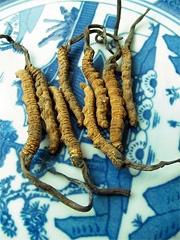Cordyceps sinensis
- Name
- Origin
- Where Does It Grow?
- Nature and Flavor
- Identified Active Components / Major Chemical Constituents
- Drug Actions in TCM
- Traditional Uses in TCM
- Pharmacological Actions
- Toxicology
- Administration and Dosage
- Adverse Effect, Side Effects and Cautions
- References

Name
Latin Name: Cordyceps sinensis
Common Name: Caterpillar fungus / Cordyceps
Scientific Name: Cordyceps sinensis (Berk.) Sacc.
Chinese Name: 冬蟲夏草
Pinyin Name: dong chong xia cao
Origin
Cordyceps sinensis is a fungus that parasitizes caterpillars, specifically the larva of the hepialid moth (also known as the bat moth). When the fungus parasitizes the larva, its mycelia, which is a mass of branching, threadlike hyphae, fill the entire body of the host and kills it. The entire fungus-larva combination is collected for medical use.1
Where Does It Grow?
Cordyceps is mainly grown at an altitude of 3500-4500 meters on plateau areas, such as Sichuan, Qinghai and Tibet in China.1
Nature and Flavor
Cordyceps is sweet in flavor, slightly warm in nature, and mainly manifests its therapeutic actions in the lung and kidney meridians.2
Identified Active Components/ Major Chemical Constituents
Major chemical constituents in Cordyceps include nucleosides such as adenosine, adenine, hypoxanthicine nucleoside, uracil, thymine, uridine, guanidine, thymidine, 3'-deoxyadenosine (also called cordycepin); sterides such as ergosterol peroxide, cholesteryl palmitate, eogosterol; polysaccharides such as galactomannan; alkanols such as D-mannitol (also called cordycepic acid). It also contains a large quantity of crude proteins, essential amino acids, multiple trace elements and some vitamins.3Drug Actions in TCM
Cordyceps enhances kidney yang, invigorates the lung to ease breathing difficulties, stops bleeding and dissolves phlegm. 2Traditional Uses in TCM
Cordycens enhancs kidney yang and replenishes essenceIt is often applied in the treatment of kidney weakness presenting with lumbar and knee soreness, impotence and spermatic emission, cordyceps can be used alone and prepared as a medicinal wine, or combined with herbs like epimedium, morinda root or dodder seed.2
This can ease breathing difficulties, stop bleeding and dissolve phlegm: for the treatment of breathing problems like asthma, cordyceps is usually used with ginseng, walnut and gecko; for the treatment of chronic cough with phlegm or blood, it is usually combined with coastal glehnia root (bei sha shen), tendrilleaf fritillary bulb (chuan bei mu) and donkey-hide gelatin.2
Due to aging or major illness, individuals may present with general weakness, anemia, sweating and sensitivity to low temperatures. Cordyceps can be used to stew with meat for enhancing overall bodily functioning or restoration.2
Pharmacological Actions
Toxicology
Cordyceps has an extremely low level of toxicity. Mice have been shown to tolerate up to 45g/kg of Cordyceps, which is approximately 250 times the therapeutic dosage for humans. The LD50 in mice via intraperitoneal injection is 21.7±1.3 g/kg. 14
Administration and Dosage
Cordyceps can be administrated as a decoction, powder mixture or stew, 5-10g each time.2Adverse Effect, Side Effects and Cautions
No interaction or adverse effects are reported.4References
- 李家實主編《中藥鑒定學》上海科學技術出版社, 2000年2月.
- 雷載權主編《中藥學》上海科學技術出版社, 2000年6月.
- 趙中振,蕭培根主編《當代藥用植物典》香港賽馬會中藥研究院有限公司, 2006年8月.
- Natural Medicines Comprehensive Database, compiled by the editors of Prescriber's Letter & Pharmacist's Letter, 4th edition.
- Gu YX, et al. Antioxidant activity of natural and cultural Cordyceps sp. Zhongguo Zhong Yao Za Zhi; 32: 1028-1031. (2007)
- Hui MY, et al. Comparison of protective effects between cultured Cordyceps militaris and natural Cordyceps sinensis against oxidative damage. Journal of Agricultural and Food Chemistry. 54: 3132-3138. (2006)
- Tzeng YM, et al. Evaluation of the anti-inflammatory and anti-proliferation tumoral cells activities of Antrodia camphotata, Cordyceps sinensis, and Cinnamomum osmophlpeum bark extracts. Journal of Ethnopharmacology. In press. (2007)
- Huang H, et al. Inhibitory effects of cordyceps extract on growth of colon cancer cells. Zhong Yao Cai; 30: 310-313. (2007)
- Suh HJ, et al. Antifatigue and antistress effect of the hot-water fraction from mycelia of Cordyceps sinensis. Biological and Pharmaceutical Bulletin; 26: 691-694. (2003)
- Kuo YC, et al. Regulation of bronchoalveolar lavage fluids cell function by the immunomodulatory agents from Cordyceps sinensis. Life Science; 68: 1067-1082. (2001)
- Li FH, et al. Effects of Cordyceps sinensis on dimethylnitrosamine-induced liver fibrosis in rats. Zhong Xi Yi Jie He Xue Bao; 4: 514-517. (2006)
- Hui PK, et al. Cordyceps sinensis improved post-SARS pulmonary fibrosis. Hua Xia Yi Yao; 3: 172-176. (2006)
- Kuo MC, et al. Immunomodulatory effect of exo-polysaccharides from submerged cultured Cordyceps sinensis: enhancement of cytokine synthesis, CD11b expression, and phagocytosis. Applied Microbiology and Biotechnology; 75:769-775. (2007)
- Chen J, Chen T, ed. Chinese Medical Herbology and Pharmacology. Art of Medicine Press, 2004; 883-885.


